ARCHIVED: Chapter 6. Hot-Mix Asphalt Recycling - Drum Plant (Construction Methods And Equipment)
| << Previous | Contents | Next >> |
Introduction
Recycled Asphalt Pavement (RAP) material, obtained by pavement milling or ripping and crushing, can be combined with new aggregate and an asphalt cement or recycling agent to produce hot mix asphalt (HMA). The process of hot mix recycling, with its comparatively low cost, and potential of producing quality mix, has proved to be a viable rehabilitation alternative. As in the case of conventional hot mix asphalt (HMA), hot mix recycling can be done in both batch (central) and drum mix plants. However, hot mix recycling in a drum mix plant offers some advantages over recycling in a batch plant which was discussed in chapter 5. These advantages are:(1)
- Portability: Drum mix plants are more portable and require shorter plant setup time compared to batch plants.
- Versatility: A relatively higher percentage of RAP can be used in a drum mix plant compared to a batch plant.
- Production: Plant production rates are relatively unaffected by RAP percentages (up to a certain limit).
- Mixing: A more homogeneous mix is produced in a drum mix plant since the RAP is heated and mixed with the virgin aggregate and asphalt binder for a longer period of time compared to the mix in a batch plant.
Recycling Processes In Drum Plants
The Reclaimed Asphalt Pavement (RAP) material cannot be processed in normal drum mix plants since excessive "blue smoke" is produced when the RAP comes in contact with the burner flame. The condition is further aggravated by build-up of fine aggregates and asphalt binder on metal flights and end plates.(2) It has been suggested(3) that most of the smoke problem is caused by the light oils in soft grade of asphalt binder used to rejuvenate the aged asphalt in the RAP. Although the smoke problem could be solved by various processes such as lowering HMA plant's production rate, increasing water content of the RAP, lowering discharge temperature of the recycled mix, introducing additional combustion air and decreasing percentage of RAP, it was found that a more effective way to rectify the problem was to modify the drum mix plant.(4)
Center Entry Method
Although variations exist in the process, basically the center entry method is the most widely used method for hot mix recycling in a drum mix plant. In this method, shown in Figure 6-1,(5) the RAP is introduced into the drum downstream of the burner flame to mix with the superheated new aggregates. The hot virgin aggregates heat up the RAP material by conduction. The RAP is protected from coming in direct contact with the burner flame by a dense veil of aggregate added prior to the point where the RAP is added. It is very important to have the veil of virgin aggregate. Otherwise, overheating of RAP can result in "blue smoke," and it may not be possible to use the design amount of RAP material. Sometimes special flight design, steel ring dams, or circular steel flame shields are utilized to force the RAP to mix with the virgin aggregates before being subjected to the high gas treatment. These techniques eliminate "blue-smoke" problem.
Figure 6-1. Schematic of drum mixer with center entry.
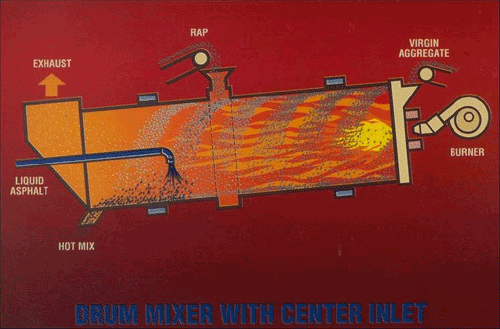
Figure 6-2 shows a drum mix plant with center entry. The virgin aggregate is kept in the hot zone of the drum and superheated to about 260°C (500°F). Kicker flights or dams are included in the middle of the drum to increase the aggregate dwell time in the first half of the drum. The superheated aggregate is used to heat the RAP materials. The aggregate temperature drops as the RAP material is heated and its moisture evaporated. The recycled mix is brought up to discharge temperature in the last portion of the drum. The parallel flow drum mixers were effectively used for recycling in the '70s and '80s. However, the plants had difficulty in complying with the growing number of restrictive emission standards. In some cases, the problem was caused by the production of steam that distilled light oil from the virgin asphalt binders and RAP.(7) The important factors contributing to the problem of emission are high moisture content of the aggregates, higher amount of fines in the RAP material and a relatively long time of exposure of the asphalt binder to the steam in the gas stream.(3) Several modified versions of the drum mix plant have been built to counter the emission problem. In general, in these methods the exposing of the asphalt binder to the steam in the exhaust gas stream has been eliminated, and this has eliminated the emission of light ends to the baghouse, except the minute amounts of light oil emitted from recycled material when a high percentage of RAP is used. Different types of drum mix plants are described below.
Figure 6-2. Drum mix plant with center entry.
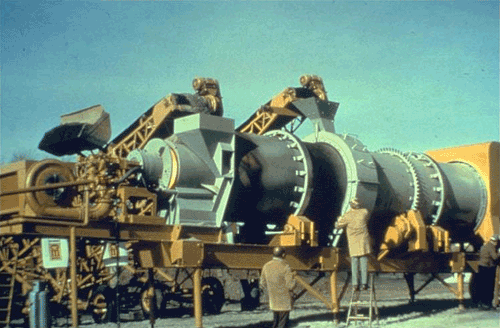
In a parallel-flow drum mixer with an isolated mixing area, the mixing device is welded to the dryer shell so that it rotates with the dryer (figure 6-3). The gas stream is removed from the dryer prior to the aggregate/RAP mixture entering the mixing area. Some designs vent to the mixing area back to the combustion area of the dryer. This equipment requires a primary collector for capture of the larger dust particles. The particles collected are typically returned to the mixing area of the dryer with a screw conveyor.
Figure 6-3. RAP in a parallel-flow drum with isolated mixing area.
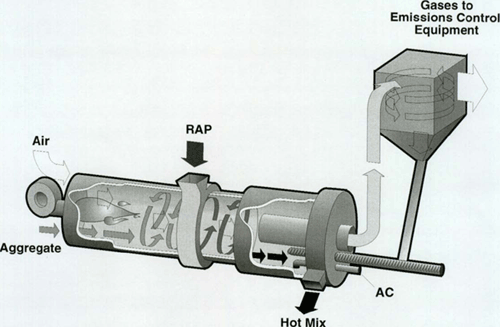
In a parallel-flow drum mixer with counterflow RAP drying tube, the RAP is introduced into a cooler portion of the dryer and travels against the gas stream to mix with the virgin aggregates in the area where the aggregate/RAP mixture enters the mixing area of the dryer (figure 6-4). In this type of drum hydrocarbon levels are greatly reduced from the gas stream because the new liquid asphalt is shielded from direct exposure to the gas stream, and the aggregate is superheated for some conductive heat transfer to the RAP while the convective heat transfer of the RAP occurs in a cooler portion of the dryer.
Figure 6-4. RAP in a drum mixer with counter-flow drying tube.
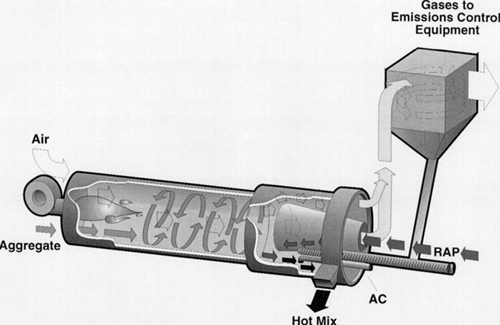
In another type of parallel-flow dryer drum, the RAP is introduced in a separate continuous mixing device (figure 6-5). RAP is heated conductively in the mixing device. In this type of drum, RAP percentages are affected by the physical space available for conductive heat transfer in the mixing device. The superheated virgin aggregates must heat the RAP, and time and space are required for the moisture to be released from the RAP. To avoid the occurrence of hydrocarbons in steam, the vapor and steam are directed back into the combustion area of the aggregate dryer which effectively burns any hydrocarbon left in that separate gas stream. However, the virgin aggregate are superheated in a parallel flow configuration, and the exhaust gas temperature is not lower than the aggregate temperature. Hence, the percentage of RAP that can be achieved with this approach can be limited by air pollution control equipment on the facility.
Figure 6-5. Parallel-flow dryer with RAP added in continuous mixer.
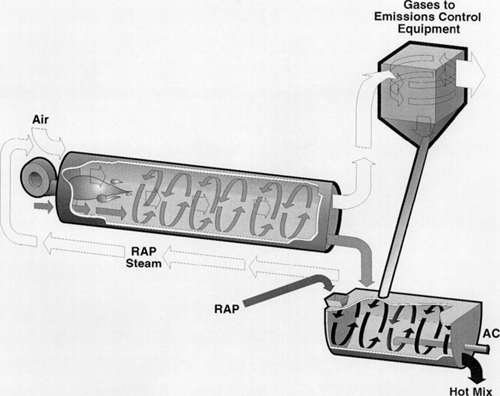
The excessively high gas temperature can be avoided by changing the dryer configuration to a counterflow dryer design (aggregate travels against gas flow (figure 6-6). A heat exchange chamber can be added to the aggregate dryer to heat the RAP with virgin aggregates in the combustion area of the dryer (figure 6-7). Higher RAP percentages are possible because RAP has a longer residence time with the superheated virgin aggregates, and because RAP is heated conductively with aggregate in the vicinity of the hottest part of the dryer shell.
Figure 6-6. Counter-flow dryer with RAP added in continuous mixer.
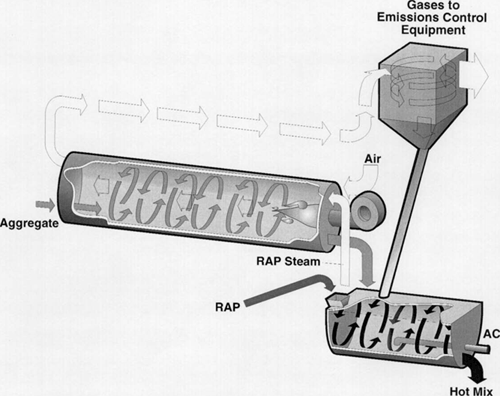
Figure 6-7. RAP added in counter-flow dryer.
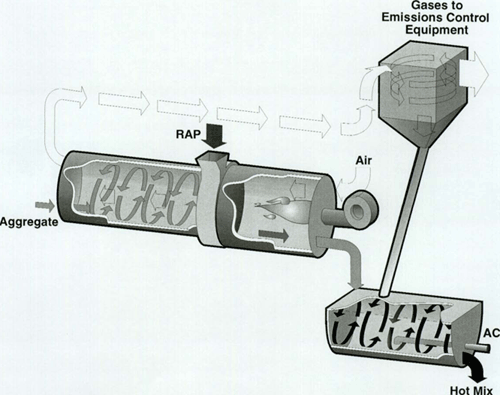
In a counterflow drum mixer, a mixtured dryer and a continuous mixing drum is combined in one unit (figure 6-8). In this type of drum mixer, the virgin aggregate is heated convectively, the RAP is heated conductively, and the virgin asphalt binder, recycled fines from primary and secondary collector, and other additives are added in the mixing section that is attached and rotating with the shell.
Figure 6-8. RAP in a counter-flow drum mixer.
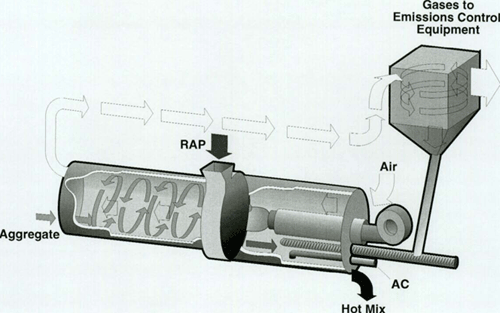
In a unitized counterflow dryer and continuous mixer (figure 6-9), a counterflow aggregate dryer is combined with a continuous pugmill mixing device. The aggregate passes through the inside of the counterflow dryer, and then is discharged with a fixed outer mixing shell where the mixing paddles move the virgin aggregate "uphill" through a mixing bed from between the rotating drying shell and the fixed rotor mixing shell. RAP is introduced at this point, along with virgin asphalt binder, recycled fines and additives, to produce HMA. This concept has been utilized in the "double barrel" drum, discussed later.
Figure 6-9. RAP added in unitized dryer/mixer.
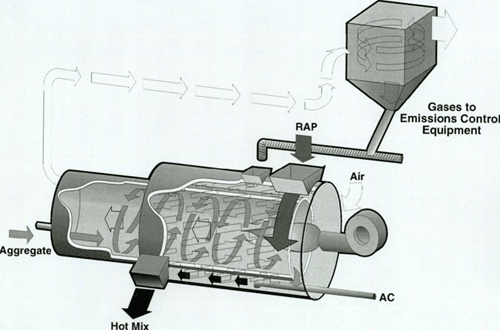
Since the late 80s two new drum designs for more efficient heat transfer to RAP material during mixing have been developed. These are double barrel and triple drum design.
The double barrel counterflow drum mix plant, shown in figure 6-10,(3) has more mixing space than a conventional drum mixer. The shell of the drum is used as the shaft of the coater. A 3 to 3.3-m (10 to 11-ft) diameter coater is created with an extremely large insulated mixing area. The virgin aggregate material is dried in the inner drum and superheated to 315°C - 343°C (600-650°F) (when running 50 percent RAP). It then drops through the wall of the drum and meets with the RAP in the annular space. Approximately 1½ minutes of mixing time occurs in this outer shell. Since the outer shell does not rotate, easy access is available to add various other recycle components to the process as they become necessary and available. The heat of the inside barrel is transferred through the rotating shell to mixing in the annular space. The outer shell of the double barrel remains at approximately 49°C (120°F) at all times, leading to a very efficient plant. In this method the virgin and the RAP material are not exposed to the hot gases or to the steam of the drying process and thus the light oils are not removed from the mix. In the outer section of the double barrel, due to the moisture removed from the RAP, a steam or inert atmosphere occurs resulting in a much lower oxidation or short-term aging of the recycled HMA mix in the mixing chamber. Another benefit derived from this type of plant is the much longer life occurring with the bags in the baghouse due to relatively lower temperature of the exhaust gases. As dust is discharged from the baghouse through a rotary airlock on the double barrel plant a screw conveyor is used to transfer the mix back into the outer shell. The holes through which the virgin aggregates are directed into the outer shell are also responsible for channelizing any smoke from the inner mixing section to the outer space. The pollutants go directly to the flame where they are burnt. This results in reduced emission and blue smoke. The counterflow dryer design also leads to higher production rates with much lower fuel consumption.
Figure 6-10. Double barrel drum mixer.
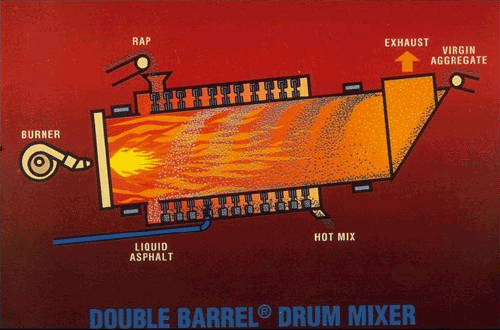
The triple drum design also uses an outer shell, however, a stainless steel cylinder is used to enclose the combustion chamber (figure 6-11). This cylinder (without any flight or steps of a regular drum) is believed to be effective in transferring heat to the RAP material through conduction and radiation. The virgin aggregate is introduced from the opposite end of the burner flame. The RAP material is introduced in the annular space formed by the outer shell. The superheated virgin aggregates fall into the annular space and mingle with the RAP material.(8)
Figure 6-11. Schematic of triple drum mixer.
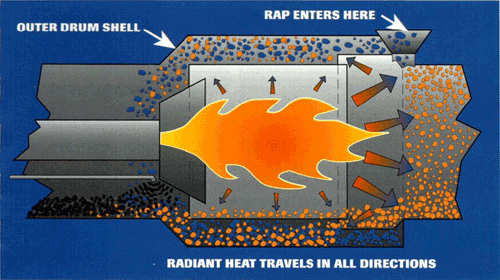
Amount Of Rap Used
The factors controlling the production limit in a drum mix plant are the moisture content and ambient temperature of the RAP and new aggregate, the desired production rate, and the temperature and allowable moisture content in the final recycled HMA mix.(5) The maximum amount of RAP that can be used for recycling in a drum mix plant is about 70 percent, although the practical limit is about 50 percent. The use of 50 percent RAP would require extremely high gas temperature and in that case a relatively smaller amount of virgin aggregates would be available to protect the RAP from the flame. This may lead to "blue smoke" problem in some drum mix plants. Most drum mix plants recycle 30 to 50 percent of RAP.
Figures 6-12 through 6-14 show plots constructed from results of a survey of allowable RAP percentages for different states.(10) Figure 6-12 shows maximum allowable percentage of RAP for drum-mix plant in base course. The most common percentage is 50, allowed by 32 percent of states, whereas 22 percent of the states have no limit on the amount of RAP that can be used. Figure 6-13 shows the maximum allowable percentage of RAP for drum-mix plant in binder course. The limits range from none to unlimited percentage of RAP. A large number of states (30 percent) allow 50 percent RAP. About 20 percent of the states have open or no limit provision for use of RAP. The maximum allowable percentages of RAP for drum-mix plant in surface are shown in figure 6-14. About 18 percent of the states do not allow any RAP, and about 16 percent have no limit on the amount of RAP.
Figure 6-12. Maximum RAP percent allowed for drum-mix plant in base course.
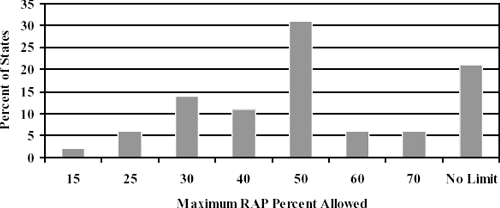
Figure 6-13. Maximum RAP percent allowed for drum-mix plant in binder course.
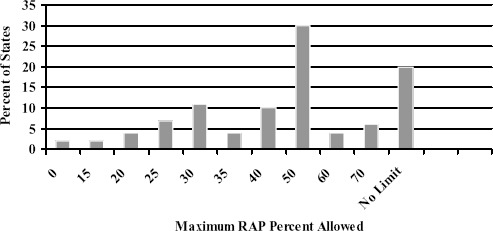
Figure 6-14. Maximum RAP percent allowed for drum-mix plant in surface course.
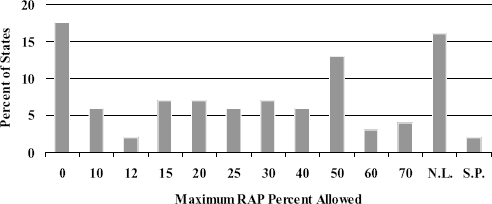
Feeder Systems
A conventional cold feed system can be used to supply crushed RAP to the drum mix plant. However, to allow easy discharge and avoid stacking problems, the bin should have relatively low capacity, with steep sides and long and wide bottom. The RAP material should not be supplied to the bin as a unit drop as it can cause compaction of the RAP with resultant bridging, sticking and discharge problems. Instead, the material should be dribbled as much as possible.(4) Also, the bin should not be vibrated as this may lead to compaction of the RAP. Both belt and slat type feeders have been used successfully. On warm days RAP should not be left in the bin for more than two hours in case of plant shutdown. It is better to keep the bin half full and feed frequently. Feeders should be fairly wide and should have sufficient horsepower to be used in a start-stop operation as necessary.(4) Vibratory type feeders are not recommended to avoid consolidation and sticking problems.(9)
With computerized controls, it is now possible to achieve automatic process control of mixing operations. Mix designs can be effectively controlled by controlling belt speeds, liquid asphalt flow, and blending.
Summary
When properly designed and constructed, hot recycled mixed can be used to correct pavement defects, and transform old, deficient pavements into good serviceable pavements. Hot mix recycling offers many advantages over conventional HMA construction. It eliminates the disposal problems and can be done repeatedly using the same materials. Besides these usual advantages, drum mix recycling, in particular, offers many advantages including portability and versatility. Drum mix recycling needs minor modification to existing plants, and since retrofit kits are easily available at present, it is rapidly becoming one of the most popular recycling processes. The most widely used method is that with the center entry type drum mix plant. The RAP is introduced into the drum downstream of the burner flame to mix with the superheated new aggregates. Special fixtures such as flights or rings are provided to force the RAP to mix with the virgin aggregates before being subjected to the high gas temperature, thus avoiding generation of smoke. Different modifications have been devised to control emission problems during mixing, caused by high moisture content of aggregates and the relatively long time of exposure of the asphalt binder to high temperature. Double and triple drum mix plants have also been used to prevent the virgin and RAP materials from being exposed to hot gases or steam of the drying process. The factors controlling the production limit in a drum mix plant are the moisture content and ambient temperature of the RAP and new aggregate. A practical limit of 30:70 (30 percent RAP and 70 percent new aggregate) has been recommended in the available literature.
References
- Pavement Management Systems Limited. Study of Hot Mix Recycling of Asphalt Pavements, Roads and Transportation Association of Canada (RTAC), Ottawa, Ontario, January 1983.
- Asphalt Hot-Mix Recycling, The Asphalt Institute Manual Series No. 20 (MS-20), Second Edition, 1986.
- J.D. Brock. Light Oils in Asphalt, Technical Paper T-116, Undated.
- Pavement Recycling Guidelines for Local Governments - Reference Manual, Report No. FHWA-TS-87-230, FHA, U.S. Department of Transportation, Washington, DC, 1987.
- Proven Guidelines for Hot-Mix Recycling, Asphalt Recycling and Reclaiming Association, Annapolis, MD, 1986.
- J.D. Brock. Dryer Drum Mixer, Astec Industries, Chattanooga, TN, undated.
- J.D. Brock. Milling and Recycling, Technical Paper T-127, undated.
- Information received from Jim Rodriguez, CMI Corporation, OK.
- National Asphalt Pavement Association. Hot Recycling in Hot-Mix Batch Plants, Information Series No. 71, Riverdale, MD, (reprint), 1985.
| << Previous | Contents | Next >> |

